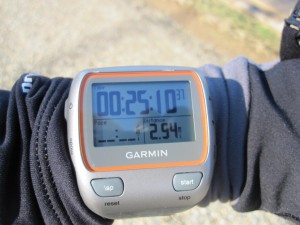The Course Was Long!
Your friend has just run the Shamrock’n Half Marathon and you ask her how it went. “I was a few minutes slower than I was hoping,” she says. “But the course was a little long. My Garmin shows 13.3 miles so if I take off that extra two-tenths of a mile, I’m exactly where I should be.”
This, of course, is nonsense. Every race, and every race day, has its own idiosyncrasies. While your GPS watch may be a wonderful training tool, and amazingly accurate, what it shows during a race cannot be used to check the accuracy of the course measurement.
Although it will happen occasionally that a course is measured inaccurately, or marked incorrectly on race day, most are remarkably close to their specified distance.
When a course is measured for certification, the certifier measures the shortest possible way to run a given course. When you run the course during an actual race, it is nearly impossible to run this same distance even if you do your best to run the tangents.
During an actual race, you’ll be moving around other runners, veering to the edge of the course to get water from the aid stations, being pushed to the outside of the curve, and running around parked cars and leaf piles. All this adds distance to the miles counted by your GPS watch.
And sometimes, your GPS is just plain wrong.
A few days ago, the New York Times published a story about the unreliability of GPS watches–particularly under certain conditions. It’s worth a read, especially before you criticize a race director about the accuracy of her course.
I do take exception to the author comparing the readings he was getting on his GPS with measurements of the same course using Google Maps. I would argue that Google Maps is probably not the gold standard for measuring a running route.
The funniest thing to me about this article, is that it quotes extensively a certain Douglas Thurston, who is the operations director for the Competitor Group, the organizer behind the Rock ’n’ Roll Marathons. Those of us who’ve been around a while will remember Doug as a long-time Sacramento runner and coach.
It really is a small world, but don’t expect your GPS watch to accurately measure just how small it is.


Great article. The only time to worry is if the GPS measures the course as “short”. Unless you watch skips out for a period of time, it will always measure long not short. If it measures short, the course probably is short…and due to the factors discussed in the article, probably short by more than your watch says it is.
1It seems GPS is most accurate in straight lines (no surprise) and will most often read longer than any accurately measured race course. However, I think they tend to read short on a track or curvy trail since they record a sampling of your positions, so the more changes of direction the less accurate the record.
2And it’s certainly true that GPS is not accurate enough at this point to say whether a course is short or long, though I did experience one race in which everyone’s GPS was reading about 6.7-6.8 miles for a 10k, which seemed suspicious (along with most runners finishing times relative to similar races).
3Great post. I find on most races my GPS measures about 1 to 3% long and that matches up to the fact that a certified course actually has to be measured 1% longer than the stated distance. On trail courses the Garmin always measures short and that has everything to do with the fact that Garmin works best when going straight.
But by comparing the GPS watch to google maps to show that the Garmin is inaccurate is just wrong. If the writer is using something like “map my ride” he is using a tool that it is doing the same thing the Garmin is – smoothing turns – and this is inaccurate as well. Using mile markers on the bike trail that I know to be accurate my Garmin always measures 1.01 to 1.02 for that distance. That is dam good for a training tool.
4Hey watch it that first paragraph is slander. We will be contacting our lawyer to file suit. Just kidding.
Hey I am a RD and I have no problem with Garmins. I use them all the time to back up our measurements to make sure we are on target and they are fairly accurate 99% of the time. If you run a certified course and the Garmin says your distance was wrong it’s probably one of a few things: A. Course was setup wrong (this happened a few times on SOME races in town). B. You didn’t run the tangents. C. The course wasn’t actually certified.
There is a short course prevention factor added into all race calculations to make sure that a certified course can’t be run short. So if it’s a touch long that’s how it’s supposed to be. Wow what did we do before Garmin I forgot.
5Well, Chad, I did say it was nonsense! I also love my Garmin and, like you, have used it to do a “rough draft” of the course before we measure it off with a Jones counter.
People really have no sense of how much “running the tangents” can shorten the distance you run during a race. Just look at the stagger distance in a 400 meter track! The difference in length between adjacent lanes is significant!
6